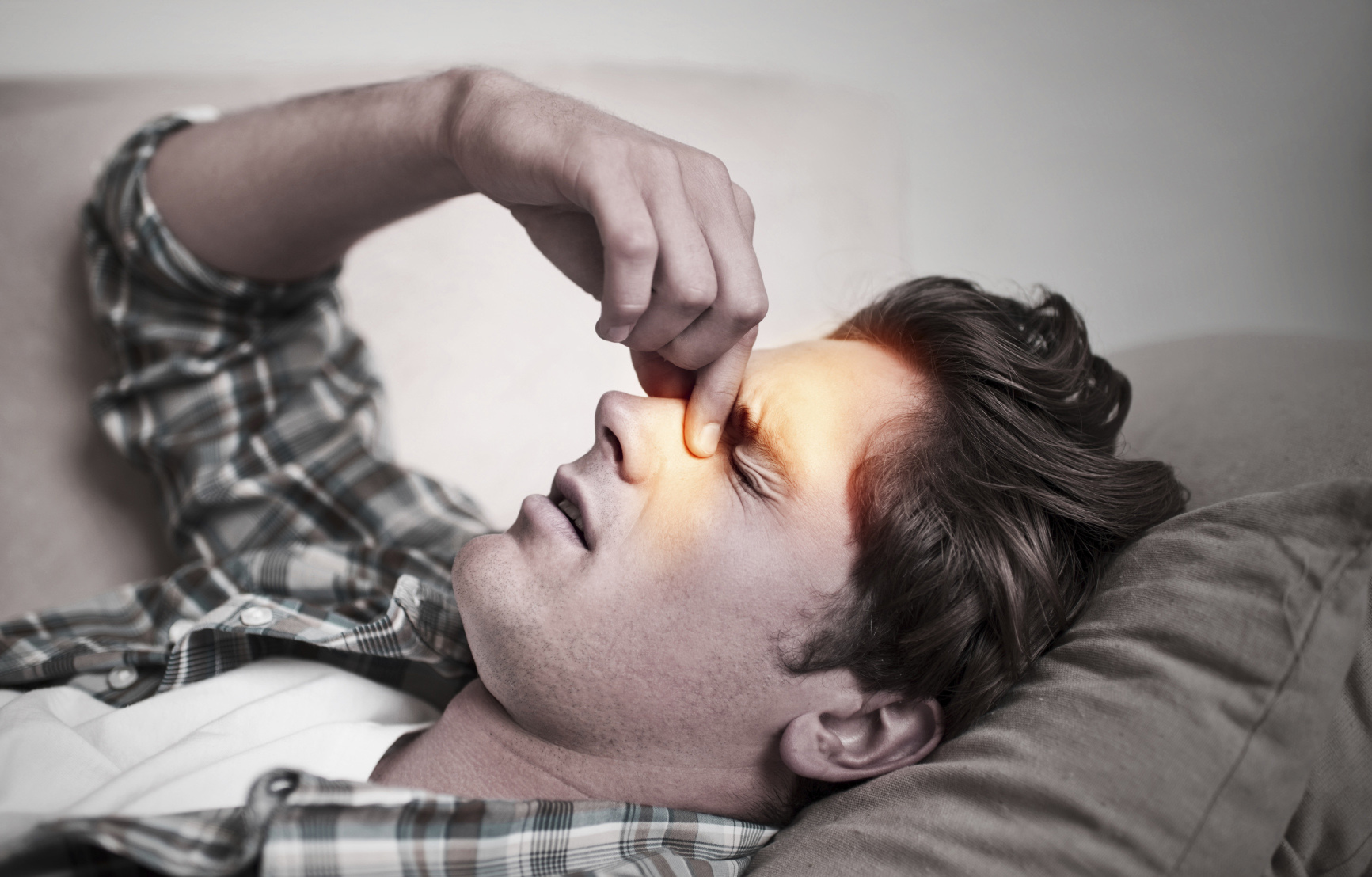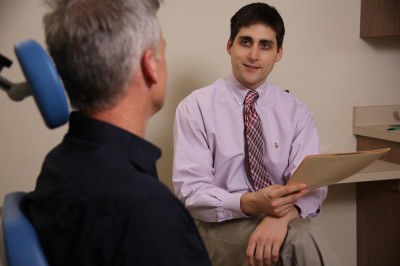Sinusitis

Have you ever had a cold or allergy attack that wouldn’t go away? If so, there’s a good chance you actually had sinusitis.
Experts estimate that 37 million people are afflicted with sinusitis each year, making it one of the most common health conditions in America. That number may be significantly higher, since the symptoms of bacterial sinusitis often mimic those of colds or allergies, and many sufferers never see a doctor for proper diagnosis and treatment.
Ready for Relief? Make an Appointment Now >
What is sinusitis?
Acute bacterial sinusitis is an infection of the sinus cavities caused by bacteria. It usually is preceded by a cold, allergy attack, or irritation by environmental pollutants. Unlike a cold, or allergy, bacterial sinusitis requires a physician’s diagnosis and treatment with an antibiotic to cure the infection and prevent future complications.
Normally, mucus collecting in the sinuses drains into the nasal passages. When you have a cold or allergy attack, your sinuses become inflamed and are unable to drain. This can lead to congestion and infection. Your doctor will diagnose acute sinusitis if you have up to 4 weeks of purulent nasal drainage accompanied by nasal obstruction, facial pain-pressure-fullness, or both. The sinus infection is likely bacterial if it persists for 10 days or longer, or if the symptoms worsen after an initial improvement.
Below is an up close, graphic video of the misery that is sinusitis. If you have a queasy stomach, you may not want to watch it!
We can bring you relief!
Because the symptoms of sinusitis sometimes mimic those of colds and allergies, you may not realize you need to see a doctor. If you suspect you have sinusitis, review these signs and symptoms. If you suffer from three or more, please contact us for an appointment.
When does sinusitis become chronic sinusitis?

When you have frequent sinusitis, or the infection lasts three months or more, it could be chronic sinusitis. Symptoms of chronic sinusitis may be less severe than those of acute; however, untreated chronic sinusitis can cause damage to the sinuses that sometimes requires surgery to repair.
Treatment for Chronic Sinusitis
Fortunately, there is a treatment available for chronic sinusitis. Balloon Sinuplasty is a minimally-invasive treatment option that gently clears the nasal passages, allowing our ENT to cleanse the sinuses with saline solution, eliminating infection. The inflation of the balloon device opens the sinus passages to allow proper drainage and breathing.
Learn more about Balloon Sinuplasty.
What treatments are available for sinusitis?
Antibiotic therapy: Therapy for bacterial sinusitis should include an appropriate antibiotic. If you have three or more symptoms of sinusitis (see chart), be sure to see your doctor for diagnosis. An oral or nasal spray or drop decongestant may be recommended to relieve congestion, although you should avoid prolonged use of nonprescriptive nasal sprays or drops. Inhaling steam or using saline nasal sprays or drops can help relieve sinus discomfort.
Antibiotic resistance means that some infection-causing bacteria are immune to the effects of certain antibiotics prescribed by your doctor. Antibiotic resistance is making even common infections, such as sinusitis, challenging to treat. You can help prevent antibiotic resistance. One way is to wait up to 7 days before taking antibiotics for mild sinus infections, allowing time for your body to fight the infection naturally. If the doctor prescribes an antibiotic, it is important that you take all of the medication just as your doctor instructs, even if your symptoms are gone before the medicine runs out.
Intensive antibiotic therapy: If your doctor thinks you have chronic sinusitis, intensive antibiotic therapy may be prescribed. Surgery is sometimes necessary to remove physical obstructions that may contribute to sinusitis.
Sinus surgery: Surgery should be considered only if medical treatment fails or if there is a nasal obstruction that cannot be corrected with medications. The type of surgery is chosen to best suit the patient and the disease.
Functional endoscopic sinus surgery (FESS) is recommended for certain types of sinus disease. With the endoscope, the surgeon can look directly into the nose, while at the same time, removing diseased tissue and polyps and clearing the narrow channels between the sinuses. The decision whether to use local or general anesthesia will be made between you and your doctor, depending on your individual circumstances.
Before surgery, be sure that you have realistic expectations for the results, recovery, and postoperative care. Good results require not only good surgical techniques, but a cooperative effort between the patient and physician throughout the healing process. It is equally important for patients to follow pre- and postoperative instructions.
Have you tried all these treatments, and still felt no relief?
That means you may have chronic sinusitis. If you symptoms have lasted for more than 8 weeks at a time, or have been resistant to any of the treatments mentioned above, you may benefit from a gentle, minimally-invasive procedure called Balloon Sinuplasty.
Ready for Relief? Make an Appointment for a Balloon Sinuplasty Consultation >
Is it sinusitis, a cold, or an allergy?
Sometimes the symptoms of sinusitis can be similar to those of a common cold or an allergy. Use the table below to determine if you have sinusitis, and if you think you do, contact our office for an appointment. If left untreated, sinusitis can lead to other medical conditions and begin to affect your quality of life.
| SIGN / SYMPTOM | SINUSITIS | ALLERGY | COLD |
| Facial Pressure / Pain | Yes | Sometimes | Sometimes |
| Duration of Illness | Over 10-14 days | Varies | Under 10 days |
| Nasal Discharge | Whitish or colored | Clear, thin, watery | Thick, whitish or thin |
| Fever | Sometimes | No | Sometimes |
| Headache | Often | Sometimes | Sometimes |
| Pain in Upper Teeth | Sometimes | No | No |
| Bad Breath | Sometimes | No | No |
| Coughing | Sometimes | Sometimes | Yes |
| Nasal Congestion | Yes | Sometimes | Yes |
| Sneezing | No | Sometimes | Yes |
Can children suffer from a sinus infection?
Your child’s sinuses are not fully developed until age 20. However, children can still suffer from sinus infection. Although small, the maxillary (behind the cheek) and ethmoid (between the eyes) sinuses are present at birth.
Sinusitis is difficult to diagnose in children because respiratory infections are more frequent, and symptoms can be subtle. Unlike a cold or allergy, bacterial sinusitis requires a physician’s diagnosis and treatment with an antibiotic to prevent future complications.
The following symptoms may indicate a sinus infection in your child:
- a cold lasting more than 10 to 14 days, sometimes with low-grade fever
- thick yellow-green nasal drainage
- post-nasal drip, sometimes leading to or exhibited as sore throat, cough, bad breath, nausea and/or vomiting
- headache, usually not before age 6
- irritability or fatigue
- swelling around the eyes
If these symptoms persist despite appropriate medical therapy, care should be taken to seek an underlying cause. The role of allergy and frequent upper respiratory infections should be considered.
How can sinusitis be prevented?
As always, an ounce of prevention is worth a pound of cure. To avoid developing sinusitis during a cold or allergy attack, keep your sinuses clear by:
- Using an oral decongestant or a short course of nasal spray decongestant
- Gently blowing your nose, blocking one nostril while blowing through the other
- Drinking plenty of fluids to keep nasal discharge thin
- Avoiding air travel. If you must fly, use a nasal spray decongestant before take-off to prevent blockage of the sinuses allowing mucus to drain
- If you have allergies, try to avoid contact with things that trigger attacks. If you cannot, use over-the-counter or prescription antihistamines and/or a prescription nasal spray to control allergy attacks
Allergy testing, followed by appropriate allergy treatments, may increase your tolerance of allergy-causing substances.


